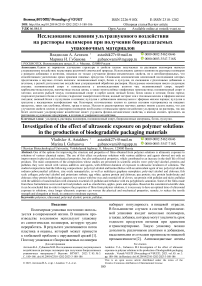Исследование влияния ультразвукового воздействия на растворы полимеров при получении биоразлагаемых упаковочных материалов
Автор: Астахов В.А., Губанова М.И.
Журнал: Вестник Воронежского государственного университета инженерных технологий @vestnik-vsuet
Рубрика: Химическая технология
Статья в выпуске: 3 (97) т.85, 2023 года.
Бесплатный доступ
Одним из вариантов улучшения структуры и свойств пленок получаемых из растворов полимеров является ультразвуковое воздействие на растворы различной химической природы. Использование данного влияния на растворы полимеров с разными добавками и агентами, показало не только улучшение физико-механических свойств, но и антибактериальных, что способствовало увеличению срока хранения пищевых продуктов. Основными компонентами композиций исследования которых представлены в научных статьях являлись: поливиниловый спирт, белки и пуллулан, их смешивали с различными добавками и агентами, с разной длительностью воздействия ультразвуковой обработки растворов. Исследуемые композиции имели следующие составы: поливиниловый спирт и гемицеллюлоза с антиоксидантным агентом чая; поливиниловый спирт, натрий-карбоксиметилцеллюлоза, наночастицы оксида цинка, а также многослойные графеновые нанопластины; поливиниловый спирт и хитозан; коллаген рыбьей чешуи, поливиниловый спирт и сорбат калия; яичный белок; белок киноа и хитозан; белок гороха; гидролизат рисового белка и хитозан; гидролизат сывороточного белка; водный экстракт сои с пчелиным воском и эфирном маслом гвоздики; овсяный белок с пуллуланом и низином; пуллулан с добавлением наноэмульсии с эфирным маслом корицы; пуллулан и трегалоза с насыщением полифенолами чая. Некоторые изготовленные пленки из данных составов тестировались на пищевых продуктах, таких как клубника, яблоко, груша и кексы. Исходя из рассмотренных научных данных можно сделать вывод, что для улучшения свойств пленок из растворов полимеров необходимо, оптимальное время воздействия ультразвука на растворы, так как более длительное ультразвуковое воздействие может ухудшить физико-механические свойства, а именно снизить прочность на растяжение и удлинение при разрыве, в отличии от умеренного воздействия.
Ультразвук, растворы полимеров, поливиниловый спирт, биоразлагаемые материалы, белок, пуллулан
Короткий адрес: https://sciup.org/140303237
IDR: 140303237 | DOI: 10.20914/2310-1202-2023-3-180-186
Список литературы Исследование влияния ультразвукового воздействия на растворы полимеров при получении биоразлагаемых упаковочных материалов
- Талипова Г.А., Галяветдинов Н.Р. Разработка биоразлагаемых композиционных материалов из полимера и растительного наполнителя // Актуальные проблемы биологии и экологии: материалы международной научно-практической конференции. 2019. С. 235-240.
- Espinosa E., Rincón E., Morcillo-Martín R., Rabasco-Vílchez L. et al. Orange peel waste biorefinery in multi-component cascade approach: Polyphenolic compounds and nanocellulose for food packaging // Industrial Crops and Products. 2022. V. 187. https://doi.org/10.1016/j.indcrop.2022.115413
- Тверитникова И.С., Кирш И.А., Безнаева О.В., Банникова О.А. и др. Разработка упаковочных материалов с антими-кробными свойствами и способностью к биоразложению // Вестник Технологического университета. 2021. № 7. С. 78-83.
- Shima J., Seid M.J., Ali S., Abdorreza M.N. et al. Biodegradable green packaging with antimicrobial functions based on the bioactive compounds from tropical plants and their by-products. // Trends in Food Science & Technology. 2020. V. 100. P. 262-277. https://doi.org/10.1016/j.tifs.2020.04.017
- Wang Y., Li J., Guo X., Wang H. et al. Active Biodegradable Polyvinyl Alcohol-Hemicellulose/Tea Polyphenol Films with Excellent Moisture Resistance Prepared via Ultrasound Assistance for Food Packaging. // Coatings. 2021. V. 11. https://doi.org/10.3390/coatings11020219
- Yaowen L., Shuyao W., Weijie L., Wen Q. Development of ultrasound treated polyvinyl alcohol/tea polyphenol composite films and their physicochemical properties // Ultrasonics Sonochemistry. 2019. V. 51. P. 386. https://doi.org/10.1016/j.ultsonch.2018.07.043
- Ji T., Zhang R., Dong X., Sameen D.E. et al. Effects of Ultrasonication Time on the Properties of Polyvinyl Alcohol/Sodium Carboxymethyl Cellulose/Nano-ZnO/Multilayer Graphene Nanoplatelet Composite Films // Nanomaterials. 2020. V. 10. https://doi.org/10.3390/nano10091797
- Ding J., Zhang R., Ahmed S., Liu Y. et al. Effect of Sonication Duration in the Performance of Polyvinyl Alcohol/Chitosan Bilayer Films and Their Effect on Strawberry Preservation // Molecules. 2019. V. 24. https://doi.org/10.3390/molecules24071408
- Liang X., Feng S., Ahmed S., Qin W. et al. Effect of Potassium Sorbate and Ultrasonic Treatment on the Properties of Fish Scale Collagen/Polyvinyl Alcohol Composite Film // Molecules. 2019. V. 24. https://doi.org/10.3390/molecules24132363
- Wanqing D., Qiong X., Xiaoxian H., Long S. Structure and properties of egg white protein films modified by high-intensity ultrasound: An effective strategy // Food Research International. 2022. V. 157. https://doi.org/10.1016/j.foodres.2022.111264
- Antonia V., Cristian T., Lilian A. Effect of high-intensity ultrasound treatment in combination with transglutaminase and nanoparticles on structural, mechanical, and physicochemical properties of quinoa proteins/chitosan edible films // International Journal of Biological Macromolecules. 2020. V. 144. P. 536. https://doi.org/10.1016/j.ijbiomac.2019.12.120
- Jingjing C., Leqi C. Effects of high-intensity ultrasound on the structural, optical, mechanical and physicochemical properties of pea protein isolate-based edible film // Ultrasonics Sonochemistry. 2021. V. 80. https://doi.org/10.1016/j.ultsonch.2021.105809
- Jingnan Z., Qian L., Qian C., Fangda S. et al. Synergistic modification of pea protein structure using high-intensity ultrasound and pH-shifting technology to improve solubility and emulsification // Ultrasonics Sonochemistry. 2022. V. 88. https://doi.org/10.1016/j.ultsonch.2022.106099
- Lingling W., Jian D., Yong F., Xin P. et al. Effect of ultrasonic power on properties of edible composite films based on rice protein hydrolysates and chitosan // Ultrasonics Sonochemistry. 2020. V. 65. https://doi.org/10.1016/j.ultsonch.2020.105049
- Karen C.-D., Ángel C., María E.F.-V., Olga D. et al. Characterization of edible films from whey proteins treated with heat, ultrasounds and/or transglutaminase. Application in cheese slices packaging // Food Packaging and Shelf Life. 2019. V. 22. https://doi.org/10.1016/j.fpsl.2019.100397
- Kumar V.A., Pravitha M., Yadav A., Pandiselvam R. et al. Influence of ultrasonic application on soybean aqueous extract based composite edible film: Characterization and their food application // Food Hydrocolloids. 2023. V. 135. P. 108210. https://doi.org/10.1016/j.foodhyd.2022.108210
- Lixin K., Qiufang L., Huanxin C., Qiusuo Z. et al. Insights into ultrasonic treatment on the properties of pullulan/oat protein/nisin composite film:mechanical, structural and physicochemical properties // Food Chemistry. 2023. V. 402. https://doi.org/10.1016/j.foodchem.2022.134237
- Yifu C., Weiwei C., Xiao F., Chengcheng G. et al. Fabrication, structure and properties of pullulan-based active films incorporated with ultrasound-assisted cinnamon essential oil nanoemulsions // Food Packaging and Shelf Life. 2020. V. 25. https://doi.org/10.1016/j.fpsl.2020.100547
- Ben N., Ping S., Hangjun C., Peilong S. Structural and physiochemical characterization of novel hydrophobic packaging films based on pullulan derivatives for fruits preservation // Carbohydrate Polymers. 2019. V. 208. https://doi.org/10.1016/j.carbpol.2018.12.070
- Lixin K., Qiufang L., Arif R., Abdul Q. et al. Ultrasound-assisted development and characterization of novel polyphenol-loaded pullulan/trehalose composite films for fruit preservation // Ultrasonics Sonochemistry. 2023. V. 92. https://doi.org/10.1016/j.ultsonch.2022.106242


